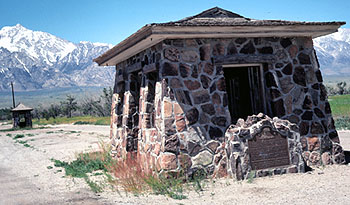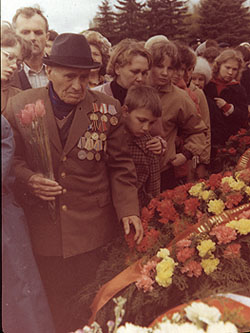![]()
What you must do in this unit
- Read chapters 25 and 26 in the textbook.
- Read my notes on Fascism and National Socialism, my remarks on Russia and World War II and my notes on the Second World War.
- Professor Campbell has two relevant videos for this unit: Is Fascism B.S.? and Is Modern Anti-Semitism B.S.?
- Read the Atlantic Charter (1941) as the basic statement of the fair peace to end the war and of basic freedoms for people.
- Study the Questions to Consider and the Key Terms for the unit.
- Review some websites with material about the Rape of Nanking Genocide.
- Submit the required Genocide group project and peer evaluations (100 points).
What you can do in this unit
- Have a look at the online presentation on the Holocaust in Poland (collaboration between myself and Professor Andrew Wise).
- Read the short paper by Bryan Grasser on Bletchley Park, Great Britain's secret code-breaking operation during World War II (*.PDF file). Bryan wrote the paper as a special project vacation option when he was enrolled in HIS 102.
- Listen to some further information about this unit as a mp3 file. You can also read the information as a txt file.
- Check World War II in Photos: A Retrospective in 20 parts (In Focus by Alan Taylor of The Atlantic).
- Read some of the great, inspirational speeches by Winston Churchill: We Shall Fight on the Beaches (Speech to the House of Commons, June 4, 1940) and Blood, Toil, Tears and Sweat (May 13, 1940).
- Miyoko Spratley (fall 2017) created this story map on Japanese War Relocation Camps 1942-1946.
- The Source List and Detailed Death Tolls for the Man-made Megadeaths of the Twentieth Century by Matthew White is an extremely interesting site that deals not just with the major wars but also famines, etc.
Some videos that you can watch for this unit
- Charlie Chaplin as the Great Dictator (his speech in the last four minutes)--the movie is a satire of Hitler's Germany.
- (Here is a pretty good video, The Fallen of World War II, that examines the heavy casualties of the war and their possible postwar impact.)
- Adolf Hitler
- Adolf Hitler (biography)
- Italy under Fascism
- Benito Mussolini (biography)
- Mussolini Executed! 1945/04/30
- World War II: Crash Course World History #38
- Why We Remember the Holocaust
- World War II: The Lost Color Archives (1/5)
- German Surrender (US newsreel footage)
- See also the videos dealing with Russia and World War II in the HIS 242 course.
- For extra credit please suggest to your instructor a relevant video for this unit of the course. Send the title of the video, the URL and a brief explanation of why you find the video interesting and applicable to the material that is being studied in this unit.
Extra Credit Options
- For up to 50 points of extra credit, submit a two-page paper comparing the experiences of colonial soldiers from West Africa in the French army with those of African-American soldiers in the US army.
- For up to 25 points of extra credit, submit the Hitler paragraph.
- For up to 25 points of extra credit, read Neville Chamberlain's Peace For Our Time speech (30 September, 1938; transcription) and then his comments on the agreement, which i'm no longer able to find on the web, in the House of Commons and write a one-page paper examining Chamberlain's intent and rationale for the Munich agreements.
- For up to 25 points of extra credit, read the Documents on the Decision to Drop the Bomb and write a one-page paper summarizing some of the pros and cons of the decision to use the atomic bomb in 1945.
- For up to 25 points of extra credit, in a one-page paper What types of evidence did the allied prosecutors bring against the Nazi leaders in the proceedings at Nuremberg?
- For up to 25 points of extra credit, write a one-page paper (maybe two pages if they are exceptional) that provides a detailed comparison of Hitler's ideas on national socialism and Benito Mussolini's What Is Fascism?
- For up to 25 points of extra credit be brave! Read Benito Mussolini (1883-1945): The Doctrine of Fascism?, 1932 and write a one-page paper explaining the main points of fascism as understood by Mussolini.
- For a maximum of 10 points extra credit (maybe more), in a long paragraph, What should people do now in respect to the atrocities that occurred before and during World War II?
- For up to 10 points of extra credit, read A. Anatolia [Kuznets], Babi Yar (1967, published in Moscow by Moldavia Sigvard) and write a long paragraph explaining why that horror occurred.
- For up to 10 points of extra credit, read the materials on Nazi-Soviet Relations 1939-1941 and write a short paragraph explaining why Germany and Russia maintained their alliance for two years.
- For up to 10 points of extra credit, read Viacheslav Molotov (1889-1986) broadcast on the Invasion of The Soviet Union (June 22, 1941) and write a paragraph explaining the key points of Molotov's speech. Note that it was Molotov, not Stalin, who announced that the Soviet Union was now at war with Germany.
- For up to 10 points of extra credit, read Adolf Hitler Reichstag Speech, (February 20, 1938) and in a paragraph explain your interpretation of Hitler's remarks.
- For up to 10 points of extra credit, read Chamberlain's speech on the Nazi Invasion of Poland (1 September 1939; transcription) and in a paragraph examine what Chamberlain must have been thinking as he faced his colleagues in the House of Commons.
- For up to 5 points of extra credit, watch Leni Riefenstahl's documentary film Triumph des Willens (Triumph of the Will) and answer the movie study questions. Please write in formal, complete sentences.
- For extra credit up to 5 points, we are always looking for photos from historical sites (graves, statues, churches, battlefields, buildings, waterfalls, mountains, etc) from around the world, particularly Russia, to use in our online courses. If you have anything that you wish to share, we would much appreciate it, and you will receive credit for your photo if we use it in one of our courses. Any photos that you send must have been taken by yourself. Please attach your photos to an email and send to Professor Evans at charles.t.evans@gmail.com. (Don’t use cevans@nvcc.edu because of email attachment size limits.) Be sure to cc your email to your current course instructor if that is not Professor Evans. This extra credit opportunity does not count against your limit of one extra credit for this unit.
Unit Learning Objectives
- Upon successful completion of this unit, you will be able to (1) define some of the characteristics of fascism and national socialism, (2) demonstrate knowledge of the scope and cost of World War II and (3) analyze historical primary sources.

